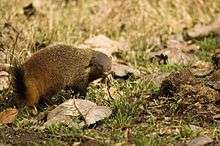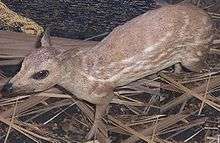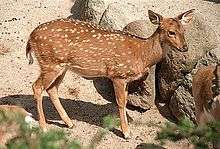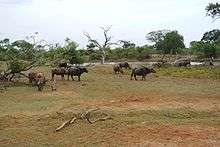List of mammals of Sri Lanka
This is a list of the mammal species recorded in Sri Lanka. There are 125 mammal species in Sri Lanka, of which 1 is critically endangered, 10 are endangered, 10 are vulnerable, and 3 are near-threatened.[1]
The following tags are used to highlight each species' conservation status as assessed by the IUCN:
| EX | Extinct | No reasonable doubt that the last individual has died. |
| EW | Extinct in the wild | Known only to survive in captivity or as a naturalized populations well outside its previous range. |
| CR | Critically endangered | The species is in imminent risk of extinction in the wild. |
| EN | Endangered | The species is facing an extremely high risk of extinction in the wild. |
| VU | Vulnerable | The species is facing a high risk of extinction in the wild. |
| NT | Near threatened | The species does not meet any of the criteria that would categorise it as risking extinction but it is likely to do so in the future. |
| LC | Least concern | There are no current identifiable risks to the species. |
| DD | Data deficient | There is inadequate information to make an assessment of the risks to this species. |
Some species were assessed using an earlier set of criteria. Species assessed using this system have the following instead of near threatened and least concern categories:
| LR/cd | Lower risk/conservation dependent | Species which were the focus of conservation programmes and may have moved into a higher risk category if that programme was discontinued. |
| LR/nt | Lower risk/near threatened | Species which are close to being classified as vulnerable but are not the subject of conservation programmes. |
| LR/lc | Lower risk/least concern | Species for which there are no identifiable risks. |
Mammalian diversity
| Class | Order | Number of species | Endemic species | Endemism |
|---|---|---|---|---|
| Mammals | Sirenia | | | |
| Proboscidea | | | | |
| Primates | | | | |
| Rodentia | | | | |
| Lagomorpha | | | | |
| Eulipotyphla | | | | |
| Chiroptera | | | | |
| Carnivora | | | | |
| Pholidota | | | | |
| Artiodactyla | | | | |
| Perissodactyla | | | | |
| Cetacea | | | |
Subclass: Theria
Infraclass: Eutheria
Order: Proboscidea (elephants)
The elephants comprise three living species and are the largest living land animals.
- Family: Elephantidae (elephants)
- Genus: Elephas
- Asian elephant Elephas maximus EN - අලියා
- Sri Lankan elephant Elephas maximus maximus
- Genus: Elephas
Order: Sirenia (manatees and dugongs)
Sirenia is an order of fully aquatic, herbivorous mammals that inhabit rivers, estuaries, coastal marine waters, swamps, and marine wetlands. All four species are endangered.
- Family: Dugongidae
Order: Primates
The order Primates contains humans and their closest relatives: lemurs, lorisoids, monkeys, and apes.
- Suborder: Strepsirrhini
- Infraorder: Lemuriformes
- Superfamily: Lorisoidea
- Family: Lorisidae (lorises, bushbabies)
- Genus: Loris
- Gray slender loris Loris lydekkerianus LC - අලු උණහපුලුවා
- Red slender loris Loris tardigradus EN - ශ්රී ලංකා රත් උණහපුලුවා
- Genus: Loris
- Family: Lorisidae (lorises, bushbabies)
- Superfamily: Lorisoidea
- Infraorder: Lemuriformes
- Suborder: Haplorhini
- Infraorder: Simiiformes
- Parvorder: Catarrhini
- Superfamily: Cercopithecoidea
- Family: Cercopithecidae (Old World monkeys)
- Genus: Macaca
- Toque macaque Macaca sinica EN - රිලවා
- Genus: Macaca
- Subfamily: Colobinae
- Genus: Semnopithecus
- Tufted gray langur Semnopithecus priam NT - හැලි වදුරා
- Purple-faced langur Semnopithecus vetulus EN - ශ්රී ලංකා කලු වදුරා
- Genus: Semnopithecus
- Family: Cercopithecidae (Old World monkeys)
- Superfamily: Cercopithecoidea
- Parvorder: Catarrhini
- Infraorder: Simiiformes
Order: Rodentia (rodents)
Rodents make up the largest order of mammals, with over 40 percent of mammalian species. They have two incisors in the upper and lower jaw which grow continually and must be keep short by gnawing. Most rodents are small though the capybara can weigh up to 45 kg (100 lb).
- Suborder: Hystricognathi
- Family: Hystricidae (Old World porcupines)
- Genus: Hystrix
- Indian porcupine Hystrix indica LC - ඉත්තෑවා
- Genus: Hystrix
- Family: Hystricidae (Old World porcupines)
- Suborder: Sciurognathi
- Family: Sciuridae (squirrels)
- Subfamily: Ratufinae
- Genus: Ratufa
- Grizzled giant squirrel Ratufa macroura NT - දඩු ලේනා
- Genus: Ratufa
- Subfamily: Sciurinae
- Tribe: Pteromyini
- Genus: Petaurista
- Indian giant flying squirrel Petaurista philippensis LC - මහ හම්බාවා
- Genus: Petinomys
- Travancore flying squirrel Petinomys fuscocapillus NT - හීන් හම්බාවා
- Genus: Petaurista
- Tribe: Pteromyini
- Subfamily: Callosciurinae
- Genus: Funambulus
- Layard's palm squirrel Funambulus layardi VU - ශ්රී ලංකා මූකලන් ලේනා
- Indian palm squirrel Funambulus palmarum LC - ලේනා
- Dusky palm squirrel Funambulus obscurus LC - ශ්රී ලංකා පුංචි ලේනා
- Genus: Funambulus
- Subfamily: Ratufinae
- Family: Muridae (mice, rats, voles, gerbils, hamsters, etc.)
- Subfamily: Gerbillinae
- Genus: Tatera
- Indian gerbil Tatera indica LC - වැලි මීයා
- Genus: Tatera
- Subfamily: Murinae
- Genus: Bandicota
- Lesser bandicoot rat Bandicota bengalensis LC - මහ ඌරු මීයා
- Greater bandicoot rat Bandicota indica LC - හීන් ඌරු මීයා
- Genus: Madromys
- Blanford's rat Madromys blanfordi LC - වලිග සුදු වන මීයා
- Genus: Golunda
- Indian bush rat Golunda ellioti LC - පදුරු මීයා
- Genus: Millardia
- Soft-furred rat Millardia meltada LC - කෙස් මුදු කෙත් මීයා
- Genus: Mus
- Little Indian field mouse Mus booduga LC - වෙල් හීන් මීයා
- Ceylon spiny mouse Mus fernandoni LC - ශ්රී ලංකා කටු හීන් මීයා
- Mayor's mouse Mus mayori NT - ශ්රී ලංකා දෙපැහැ කටු හීන් මීයා
- Genus: Rattus
- Genus: Srilankamys
- Ohiya rat Srilankamys ohiensis NT - ශ්රී ලංකා දෙපැහැ මීයා
- Genus: Vandeleuria
- Nolthenius's long-tailed climbing mouse Vandeleuria nolthenii VU - ශ්රී ලංකා ගස් මීයා
- Asiatic long-tailed climbing mouse Vandeleuria oleracea LC - ගස් මීයා
- Genus: Bandicota
- Subfamily: Gerbillinae
- Family: Sciuridae (squirrels)
Order: Lagomorpha (lagomorphs)
The lagomorphs comprise two families, Leporidae (hares and rabbits), and Ochotonidae (pikas). Though they can resemble rodents, and were classified as a superfamily in that order until the early 20th century, they have since been considered a separate order. They differ from rodents in a number of physical characteristics, such as having four incisors in the upper jaw rather than two.
- Family: Leporidae (rabbits, hares)
- Genus: Lepus
- Indian hare Lepus nigricollis LR/lc - වල් හාවා
- Genus: Lepus
Order: Soricomorpha (shrews, moles, and solenodons)
The "shrew-forms" are insectivorous mammals. The shrews and solenodons closely resemble mice while the moles are stout-bodied burrowers.
- Family: Soricidae (shrews)
- Subfamily: Crocidurinae
- Genus: Crocidura
- Horsefield's shrew Crocidura horsfieldii LR/lc - කුණු හික් මීයා
- Sri Lankan long-tailed shrew Crocidura miya EN - ශ්රී ලංකා කුණු හික් මීයා
- Sinharaja shrew Crocidura hikmiyaEN - ශ්රී ලංකා සිංහරාජ කුණු හික් මීයා
- Genus: Feroculus
- Kelaart's long-clawed shrew Feroculus feroculus EN - පිරි හික් මීයා
- Genus: Solisorex
- Pearson's long-clawed shrew Solisorex pearsoni EN - ශ්රී ලංකා නිය දිගු මාහික් මීයා
- Genus: Suncus
- Etruscan shrew Suncus etruscus LC - පොඩි හික් මීයා
- Sri Lanka shrew Suncus fellowesgordoni EN - ශ්රී ලංකා පොඩි හික් මීයා
- Sri Lanka highland shrew Suncus montanus VU - ශ්රී ලංකා කදු හික් මීයා
- Asian house shrew Suncus murinus LR/lc - පොදු හික් මීයා
- Jungle shrew Suncus zeylanicus EN - ශ්රී ලංකා කැලෑ හික් මීයා
- Genus: Crocidura
- Subfamily: Crocidurinae
Order: Chiroptera (bats)
_Kolkata_West_Bengal_India_27042013.png)
The bats' most distinguishing feature is that their forelimbs are developed as wings, making them the only mammals in the world naturally capable of flight. Bat species account for about 20% of all mammals.
- Family: Pteropodidae (flying foxes, Old World fruit bats)
- Subfamily: Pteropodinae
- Genus: Cynopterus
- Cynopterus Cynopterus brachyotis LR/lc - හීන් තල වවුලා
- Greater short-nosed fruit bat Cynopterus sphinx LR/lc - තල වවුලා
- Genus: Pteropus
- Indian flying-fox Pteropus giganteus LR/lc - මා වවුලා
- Genus: Rousettus
- Rousettus leschenaulti LR/lc - බොර කහ පලා වවුලා
- Genus: Cynopterus
- Subfamily: Pteropodinae
- Family: Vespertilionidae
- Subfamily: Kerivoulinae
- Genus: Kerivoula
- Hardwicke's woolly bat Kerivoula hardwickii LR/lc - රත් බොර කිරි වවුලා
- Painted bat Kerivoula picta LR/lc - විසිතුරු කිරි වවුලා
- Genus: Kerivoula
- Subfamily: Myotinae
- Genus: Myotis
- Lesser large-footed bat Myotis hasseltii LR/lc - බොර වවුලා
- Genus: Myotis
- Subfamily: Vespertilioninae
- Genus: Falsistrellus
- Chocolate pipistrelle Falsistrellus affinis LR/lc - බොර හීන් වවුලා
- Genus: Hesperoptenus
- Tickell's bat Hesperoptenus tickelli LR/lc - අවර වවුලා
- Genus: Pipistrellus
- Kelaart's pipistrelle Pipistrellus ceylonicus LR/lc - රත් බොර කොස්ඇට වවුලා
- Indian pipistrelle Pipistrellus coromandra LR/lc - ඉන්දු කොස්ඇට වවුලා
- Genus: Scotophilus
- Greater Asiatic yellow bat Scotophilus heathi LR/lc - මහ කහ වවුලා
- Lesser Asiatic yellow bat Scotophilus kuhlii LR/lc - හීන් කහ වවුලා
- Genus: Falsistrellus
- Subfamily: Murininae
- Genus: Murina
- Murina cyclotis LR/lc - නළ නැහැ වවුලා
- Genus: Murina
- Subfamily: Miniopterinae
- Genus: Miniopterus
- Schreibers' long-fingered bat Miniopterus schreibersii LC - දික්පිය වවුලා
- Genus: Miniopterus
- Subfamily: Kerivoulinae
- Family: Molossidae
- Genus: Chaerephon
- Wrinkle-lipped free-tailed bat Chaerephon plicata LR/lc - පොදු රැලිතොල් වවුලා
- Genus: Tadarida
- Egyptian free-tailed bat Tadarida aegyptiaca LC - මහදිව් රැලිතොල් වවුලා
- Genus: Chaerephon
- Family: Emballonuridae
- Genus: Saccolaimus
- Naked-rumped pouched bat Saccolaimus saccolaimus LR/lc - පැස්පිරී වවුලා
- Genus: Taphozous
- Long-winged tomb bat Taphozous longimanus LR/lc - දික්බා කෙපුලුම් වවුලා
- Black-bearded tomb bat Taphozous melanopogon LR/lc - රැවුලකලු කෙපුලුම් වවුලා
- Genus: Saccolaimus
- Family: Megadermatidae
- Genus: Megaderma
- Megaderma lyra LR/lc
- Lesser false vampire bat Megaderma spasma LR/lc - කන්දිගු බොරු ලේ වවුලා
- Genus: Megaderma
- Family: Rhinolophidae
- Subfamily: Rhinolophinae
- Genus: Rhinolophus
- Lesser woolly horseshoe bat Rhinolophus beddomei NT - මහ අස්ලාඩම් වවුලා
- Woolly horseshoe bat Rhinolophus luctus LR/lc - මහ අස්ලාඩම් වවුලා
- Rufous horseshoe bat Rhinolophus rouxi LR/lc - බොරත් අස්ලාඩම් වවුලා
- Genus: Rhinolophus
- Subfamily: Hipposiderinae
- Genus: Hipposideros
- Dusky roundleaf bat Hipposideros ater LR/lc - දෙපැහැ පත්නැහැ වවුලා
- Fulvus roundleaf bat Hipposideros fulvus LR/lc - මැලෑකහ පත්නැහැ වවුලා
- Cantor's roundleaf bat Hipposideros galeritus LR/lc - කෙස්දිගු පත්නැහැ වවුලා
- Indian roundleaf bat Hipposideros lankadiva LC - මහ පත්නැහැ වවුලා
- Schneider's leaf-nosed bat Hipposideros speoris LC - කෙස්කෙටි පත්නැහැ වවුලා
- Genus: Hipposideros
- Subfamily: Rhinolophinae
Order: Pholidota (pangolins)
The order Philodota comprises the eight species of pangolin. Pangolins are anteaters and have the powerful claws, elongated snout and long tongue seen in the other unrelated anteater species.

]
- Family: Manidae
- Genus: Manis
- Indian pangolin Manis crassicaudata LR/nt - කබල්ලෑවා
- Genus: Manis
Order: Cetacea (whales)
The order Cetacea includes whales, dolphins and porpoises. They are the mammals most fully adapted to aquatic life with a spindle-shaped nearly hairless body, protected by a thick layer of blubber, and forelimbs and tail modified to provide propulsion underwater.
- Suborder: Mysticeti
- Family: Balaenopteridae
- Subfamily: Balaenopterinae
- Genus: Balaenoptera
- Minke whale Balaenoptera acutorostrata LR/nt - මින්කි තල්මසා
- Bryde's whale Balaenoptera edeni DD - බ්ර්ය්ඩ් තල්මසා
- Blue whale Balaenoptera musculus EN - නිල් තල්මසා
- Fin whale Balaenoptera physalus EN - වරල් තල්මසා
- Genus: Balaenoptera
- Subfamily: Megapterinae
- Genus: Megaptera
- Humpback whale Megaptera novaeangliae CR (Arabian Sea Population)[2]
- Genus: Megaptera
- Subfamily: Balaenopterinae
- Family: Balaenopteridae
- Suborder: Odontoceti
- Superfamily: Platanistoidea
- Family: Phocoenidae
- Genus: Neophocaena
- Finless porpoise Neophocaena phocaenoides DD - අවරල් දෙනුවා
- Genus: Neophocaena
- Family: Physeteridae
- Genus: Physeter
- Sperm whale Physeter macrocephalus VU - මන්ද තල්මසා
- Genus: Physeter
- Family: Kogiidae
- Genus: Kogia
- Pygmy sperm whale Kogia breviceps LR/lc - කුරු මන්ද තල්මසා
- Dwarf sperm whale Kogia sima LR/lc - මිටි මන්ද තල්මසා
- Genus: Kogia
- Family: Ziphidae
- Genus: Ziphius
- Cuvier's beaked whale Ziphius cavirostris DD - කුවියර් උල් තල්මසා
- Subfamily: Hyperoodontinae
- Genus: Mesoplodon
- Blainville's beaked whale Mesoplodon densirostris DD - බ්ලේයින් හොබු තල්මසා
- Ginkgo-toothed beaked whale Mesoplodon ginkgodens DD - බ්ලේයින් හොබු තල්මසා
- Deraniyagala's beaked whale Mesoplodon hotaula DD - දැරණිලගලගේ උල්හොට තල්මසා
- Genus: Mesoplodon
- Genus: Ziphius
- Family: Delphinidae (marine dolphins)
- Genus: Steno
- Rough-toothed dolphin Steno bredanensis DD - රලුදත් මුල්ලා
- Genus: Sousa
- Sousa chinensis DD - රලුදත් මුල්ලා
- Genus: Tursiops
- Indo-pacific dolphin Tursiops aduncus DD - ඉන්දු පැසිෆික් බොතල්නාස් මුල්ලා
- Bottlenose dolphin Tursiops truncatus DD - බෝතල්නාස මුල්ලා
- Genus: Stenella
- Pantropical spotted dolphin Stenella attenuata LR/cd - තිත් මුල්ලා
- Striped dolphin Stenella coeruleoalba LR/cd - වෛරම් මුල්ලා
- Spinner dolphin Stenella longirostris LR/cd - බමන මුල්ලා
- Genus: Lagenodelphis
- Fraser's dolphin Lagenodelphis hosei DD - කෙටිහොට මුල්ලා
- Genus: Grampus
- Risso's dolphin Grampus griseus DD - අළු මුල්ලා
- Genus: Peponocephala
- Melon-headed whale Peponocephala electra LR/lc - පුහුල් ඔළු මුල්ලා
- Genus: Feresa
- Pygmy killer whale Feresa attenuata DD - කුරු මිනී තල්මසා
- Genus: Pseudorca
- False killer whale Pseudorca crassidens LR/lc - බොරු මිනී තල්මසා
- Genus: Orcinus
- Orca Orcinus orca LR/cd - මිනී තල්මසා
- Genus: Globicephala
- Pilot whale Globicephala macrorhynchus LR/cd - නියමු තල්මසා
- Genus: Steno
- Family: Phocoenidae
- Superfamily: Platanistoidea
Order: Carnivora (carnivorans)
There are over 260 species of carnivorans, the majority of which feed primarily on meat. They have a characteristic skull shape and dentition.
- Suborder: Feliformia
- Family: Felidae (cats)
- Subfamily: Felinae
- Genus: Felis
- Jungle cat Felis chaus LC - වල් බළලා / වල් බාවා
- Sri Lankan jungle cat Felis chaus kelaarti
- Jungle cat Felis chaus LC - වල් බළලා / වල් බාවා
- Genus: Prionailurus
- Rusty-spotted cat Prionailurus rubiginosus VU - කොල දිවියා
- Fishing cat Prionailurus viverrinus VU - හදුන් දිවියා
- Genus: Felis
- Subfamily: Pantherinae
- Genus: Panthera
- Leopard Panthera pardus LC - දිවියා
- Sri Lankan leopard Panthera pardus kotiya
- Leopard Panthera pardus LC - දිවියා
- Genus: Panthera
- Subfamily: Felinae
- Family: Viverridae (civets, genets, etc.)
- Subfamily: Paradoxurinae
- Genus: Paradoxurus
- Asian palm civet Paradoxurus hermaphroditus LR/lc - කලවැද්දා
- Golden wet zone palm civet Paradoxurus aureus LR/lc -split into 2 species.
- Sri Lanka golden striped-backed palm civet Paradoxurus stenocephalus V - ශ්රී ලංකා රන් කලවැද්දා
- Sri Lanka brown palm civet Paradoxurus montanus V - ශ්රී ලංකා බොර කලවැද්දා
- Genus: Paradoxurus
- Subfamily: Viverrinae
- Genus: Viverricula
- Small Indian civet Viverricula indica LR/lc - උරුලෑවා
- Genus: Viverricula
- Subfamily: Paradoxurinae
- Family: Herpestidae (mongooses)
- Genus: Herpestes
- Indian gray mongoose Herpestes edwardsii LR/lc - මුගටියා
- Indian brown mongoose Herpestes fuscus DD - බොර මුගටියා
- Ruddy mongoose Herpestes smithii LR/lc - හෝතබුවා
- Stripe-necked mongoose Herpestes vitticollis LR/lc - මහ මුගටියා
- Genus: Herpestes
- Family: Felidae (cats)
- Suborder: Caniformia
- Family: Canidae (dogs, foxes)
- Genus: Canis
- Golden jackal Canis aureus LC - හිවලා
- Sri Lankan golden jackal Canis aureus naria
- Golden jackal Canis aureus LC - හිවලා
- Genus: Canis
- Family: Ursidae (bears)
- Genus: Melursus
- Sloth bear Melursus ursinus VU - මන්ද වලහා
- Genus: Melursus
- Family: Mustelidae (mustelids)
- Genus: Lutra
- European otter Lutra lutra NT - දිය බල්ලා
- Genus: Lutra
- Family: Canidae (dogs, foxes)
Order: Artiodactyla (even-toed ungulates)
The even-toed ungulates are ungulates whose weight is borne about equally by the third and fourth toes, rather than mostly or entirely by the third as in perissodactyls. There are about 220 artiodactyl species, including many that are of great economic importance to humans.
- Family: Suidae (pigs)
- Family: Tragulidae
- Genus: Moschiola
- Sri Lankan spotted chevrotain Moschiola meminna LR/lc - ශ්රී ලංකා සුදු තිත් මීමින්නා
- Sri Lankan yellow-striped chevrotain Moschiola kathygre LR/lc - ශ්රී ලංකා කහ ඉරි මීමින්නා
- Genus: Moschiola
- Family: Cervidae (deer)
- Subfamily: Cervinae
- Genus: Rusa
- Sambar deer Rusa unicolor LR/lc - ගෝනා
- Sri Lankan sambar deer Rusa unicolor unicolor
- Sambar deer Rusa unicolor LR/lc - ගෝනා
- Genus: Hyelaphus
- Hog deer Hyelaphus porcinus EN/en - විල් මුවා
- Ceylon hog deer*
- Hog deer Hyelaphus porcinus EN/en - විල් මුවා
- Genus: Axis
- Chital Axis axis LR/lc - තිත් මුවා
- Sri Lankan axis deer Axis axis ceylonensis
- Chital Axis axis LR/lc - තිත් මුවා
- Genus: Rusa
- Subfamily: Muntiacinae
- Genus: Muntiacus
- Indian muntjac Muntiacus muntjak LR/lc - ඕලු මුවා / වැලි මුවා
- Sri Lankan muntjac Muntiacus muntjak malabaricus
- Indian muntjac Muntiacus muntjak LR/lc - ඕලු මුවා / වැලි මුවා
- Genus: Muntiacus
- Subfamily: Cervinae
- Family: Bovidae (bovids)
- Subfamily: Bovinae
- Genus: Bubalus
- Wild Asian water buffalo Bubalus arnee EN/en - කුළු මීහරකා
- Genus: Bubalus
- Subfamily: Bovinae
Order: Perissodactyla (odd-toed ungulates)
The odd-toed ungulates are ungulates that are equally important as Artiodactyls. There are about 17 perissodactyl species, including many that are of great economic importance to humans.
- Family: Equidae (horses)
- Genus: Equus
- Wild horse Equus ferus* LR/lc - also known as Delft pony - වල් අශ්වයා
- Donkey Equus africanus asinus LR/lc - බූරුවා
- Genus: Equus
See also
- Wildlife of Sri Lanka
- Mammals of Sri Lanka (book)
- List of chordate orders
- List of regional mammals lists
- List of prehistoric mammals
- Mammal classification
- New mammal species
Further reading
- Mammals of Sri Lanka by Asoka Yapa and Gamini Ratnavira, ISBN 978-955-8576-32-8
Notes
- ↑ This list is derived from the IUCN Red List which lists species of mammals and includes those mammals that have recently been classified as extinct (since 1500 AD). The taxonomy and naming of the individual species is based on those used in existing Wikipedia articles as of 21 May 2007 and supplemented by the common names and taxonomy from the IUCN, Smithsonian Institution, or University of Michigan where no Wikipedia article was available.
- ↑ - මොල්ලි තල්මසා Megaptera novaeangliae (Arabian Sea subpopulation)
References
- "The IUCN Red List of Threatened Species: Mammals of Sri Lanka". IUCN. 2001. Retrieved 22 May 2007.
- "Mammal Species of the World". Smithsonian National Museum of Natural History. 2005. Archived from the original on 27 April 2007. Retrieved 22 May 2007.
- "Animal Diversity Web". University of Michigan Museum of Zoology. 1995–2006. Retrieved 22 May 2007.
















